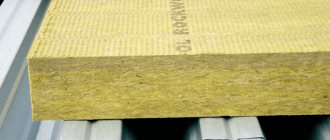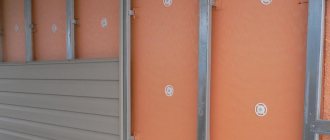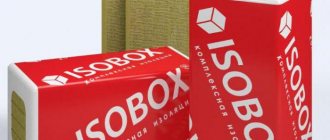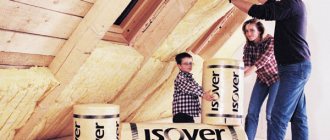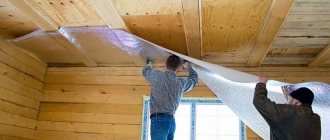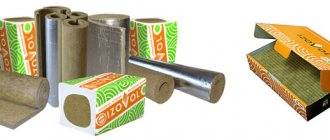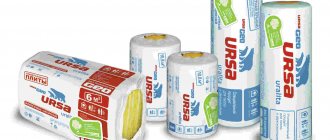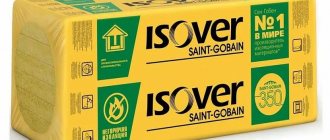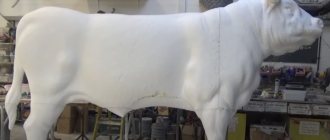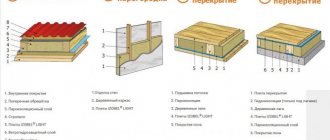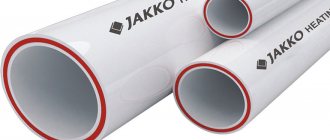They say, “the shortest road is the one you know.” By choosing time-tested materials, for example, TechnoNikol Rocklight insulation, we save time and effort. On the other hand, before making a decision, you need to check all the facts, find out the technical characteristics, and find out reviews from those who have already used this insulation. This article covers all of the above.
Definition : TechnoNikol Rocklight are semi-rigid slabs made of stone (basalt wool).
Description of insulation and technical parameters
So, what features and characteristics does Rocklight have? One of the main distinguishing features is the fire resistance of the basalt product.
Fire resistance
The material can withstand temperatures exceeding 1000°C. This became possible due to the fact that the material is made from stone. Regardless of the thickness of the mineral wool slabs, the ability of the material does not disappear. Therefore, this insulation is very often used to carry out the insulation procedure in places where the chimney is located near wooden structures. But despite this advantage, it is still advised to take additional actions that are necessary to protect against fire.
Rocklight slabs do not shrink even after a huge period of use.
Maintains shape and volume
This is possible due to the density of the material. Another advantage is vapor permeability, which is absent in polystyrene foam thermal insulators. Moisture is passed through rather than absorbed. This eliminates the occurrence of condensation on walls and other surfaces. This advantage becomes even more valuable when thermal insulation is carried out between metal profiles. If accumulation did occur, then the appearance of rust was inevitable. The material is generally not interesting to rodents and small insects. Mold and mildew are also not harmful to insulation.
Let's look at the table of technical parameters, pay attention to the table:
| Thermal conductivity | Density | Flammability class | Compressibility limit | Vapor permeability |
| 0.039-0.041 W/m×K | 30-40 kg/m3 | NG | 30% | 0.3 mg/m×h×Pa |
Let us consider separately the dimensions of the insulating material:
- length – 1200 millimeters;
- width – 600 millimeters;
- thickness – 5-15 centimeters.
If the package contains slabs of maximum thickness, then it contains four pieces. 12 pieces are included in the package if their thickness is 5 centimeters. In addition to excellent thermal insulation properties, Rocklight has excellent sound insulation properties. The material is lightweight and the installation process is quite simple.
Advantages and disadvantages
TechnoNIKOL Rocklight insulation, in comparison with other materials of this class, has the following advantages:
- low thermal conductivity;
- unique ability to save heat, which only environmentally friendly wool can compete with;
- resistance to fire and fire spread;
- the ability to maintain its shape for a long time;
- low hygroscopicity, taking into account the use of a special insulating layer;
- good absorption of sound waves, thanks to which Rocklight minply can be used for sound insulation purposes.
The material is resistant to rodents, insects and microorganisms harmful to health.
If we compare Rocklight with Rockwool, it can be noted that when creating the first, not only basalt is used, but also additives in the form of extruded polystyrene foam. Compared to other samples, this insulation material is lighter, which reduces transportation costs and simplifies installation. At the same time, it is quite durable, so it is used in places where it is unacceptable to install less rigid insulation.
The material has one drawback - high cost.
Insulation boards from Rockwool are deservedly classified as higher quality products, which at the same time have a very reasonable price. But comparable products from Rocklight have many positive properties, which attracts the attention of users to them.
Characteristics of basalt material
Mineral wool provides excellent resistance to cold, significantly superior to any other natural or artificial insulators. But when choosing Rockline insulation from the manufacturer Technonikol, you should start from your personal needs, weighing all the technical advantages and disadvantages of the product.
The thermal conductivity of the material is 0.036 W/m. This indicator fully complies with all the standards that are necessary for installing thermal insulation in cold climates.
Density is 30 kg per cubic meter. m. The indicator is not very high, but it goes well with the compression ratio, which plays a significant role when using insulation indoors and in attics as thermal insulation. Thanks to him, it will be possible to see how much it is possible to tighten the cotton wool without deforming it, because by reducing the effort, it will return to its original shape. A 30% figure is a significant result, which will be quite sufficient for the easy process of installing mineral slabs into frames on the roof or walls.
The products are produced in packs with sheet sizes of 1200×600×50 mm and 1200×600×100 mm. These dimensions are the most popular, as they are conveniently installed in frames and are light in weight. But at the same time, such a thickness of wool is quite enough to provide the structure with the proper degree of thermal insulation in the cold winter. In the case when the layer is not enough, for example, when insulating an attic, the material can be combined with each other or placed in several levels.
Peculiarities
The definition implies the features or advantages of this insulation, namely:
- Fire safety. The insulation is NG class, which means it does not contribute to the spread of fire. For many consumers, this factor is decisive when choosing stone wool insulation. The latter is preferred over polystyrene foam, which releases toxic substances when burned.
- High vapor permeability. The thermos effect is only good for tea in winter. But the room must, to a reasonable extent, not only retain, but also REMOVE heat or moisture. Otherwise, over time, a living room or office would turn into a steam room.
- Convenience and simplicity when insulating. Mineral wool Rocklight provides for installation without wet processes. And this type of installation is faster, more convenient and simpler.
- Low thermal conductivity. For the central regions of Russia, 50 mm insulation is recommended, although there are much denser options.
Technical qualities of Rocklight thermal insulation
Rocklight mineral wool is made from special rocks and is a non-flammable material. The rock is melted and stretched to form fine fibers. These fibers are collected into slabs using a binder.
Rocklight slabs come in two sizes - 50, 100 and 150 mm thick. Insulation is used to preserve heat in outbuildings, as well as in industrial and residential premises. Insulation can be used on both vertical and horizontal structures. It is perfect for insulating partitions in apartments and houses.
It will help protect the room from excess noise and cold, retaining heat.
The ease of installation of Rocklight insulation and its excellent qualities have long been rightfully valued by construction companies and private developers. It is most often used for the following works:
- insulation of external or internal walls of buildings;
- insulation of walls that are planned to be topped with siding;
- insulation of interior partitions;
- thermal insulation of floors;
- thermal insulation of ceilings;
- insulation of attic walls;
- thermal insulation of attics from which living rooms are equipped.
When fastening sheets of thermal insulation with a construction stapler, the characteristics of the material do not deteriorate. But Rocklight can also be fixed using metal profiles and wooden slats.
The technical properties of the Rocklight sealant are as follows:
- Thermal conductivity: 0.039–0.041 W/m2.
- Density: from 30 to 40 kg/m3.
- Flammability level – NG.
- The level of compressibility is not higher than 10%.
- Vapor permeability – 0.3.
- The length of the slab is 1.2 m, width 0.6 m, and thickness from 5 to 15 cm.
If the thickness of each sheet is 15 cm, 4 pieces fit in the package, with a thickness of 10 cm - from 4 to 6 pieces, 7.5 cm - 8 pieces, and 5 cm - up to 12 pieces.
Rocklight mineral wool is not only high-quality sound and thermal insulation, it does not cause problems during installation, because the slabs are very dense and light in weight.
Types and features of Rocklight insulation
Although the TechnoNIKOL company has an extensive range, the varieties of the Rocklight brand include only 2 types: with 50 mm and 100 mm thickness. Cotton wool differs from each other only in minor dimensional parameters, in particular the diameter of the layer; in all other respects, it is a material absolutely identical in its properties. From 50 mm sheets you can make surface thicknesses of 50, 100 and 150 mm by combining several coatings into one. The size of one slab is 0.72 square meters. m, and each package contains from 4-12 pieces.
Mineral wool has many advantages, thanks to which it is quite in demand among numerous buyers, having characteristics no worse, and in some places even better than its main competitor - polystyrene foam.
- Fire resistance. This insulation prevents the spread of fire over the surface, which is why many buyers prefer it, because when foam plastic burns, toxic substances are released that can cause serious harm to health. During a fire, people inside the building will have enough time to evacuate and call the fire department. The melting point is around 1000 degrees, so mineral wool does not burn, does not smoke, and does not drip in scalding drops.
- A low level of moisture absorption is achieved with vapor and waterproofing previously completed during installation. This property is a tangible advantage and the only drawback of the material. If it is used indoors, you cannot cover all surfaces with it, ensuring the supply of fresh air.
- Mineral wool has a long service life, which reaches 50-60 years. Foam sheets begin to deteriorate after 15-20 years.
- Due to its structure, it has excellent sound absorption properties and can be used to provide a building with an effective degree of sound insulation.
- Low biological activity does not contribute to the emergence of harmful fungi and microorganisms, as well as various rodents.
- The material has significant hardness and rigidity, which is why it is able to bear enormous loads. Even after a long service life, Rocklight insulation is not prone to shrinkage, maintaining its original slab shape and efficiency.
- The insulator does not corrode and is resistant to alkalis.
- Basalt wool is absolutely environmentally friendly. It does not contain components harmful to human health.
- The existing vapor permeability allows the passage and retention of the required level of heat and moisture, ventilating the room.
Where is the material used?
TechnoNicole Rocklight, as already mentioned, is a semi-rigid mineral slab. It can be used in:
- Vertical;
- Horizontal;
- Sloping surfaces.
BUT! No external load. According to the TechnoNikol company website, the material has a compression rate of 30%, and the density varies between 30 to 40 kg per m3. This density will be quite enough to withstand the vertical load under its own weight when the insulation is used in frame structures. But, it will not be enough with additional load. Therefore, this thermal insulation is not used in wet facades, but only in curtain walls.
If we give more specific examples of the use of Rocklight, we can highlight:
Sound and heat insulation of interior partitions;
Insulation of the facade under siding and other hanging systems;
Creating an attic microclimate.
For example, in the video below, representatives of TechnoNikol recommend Rocklight as insulation for the attic.
A few words about installation
Finally, let’s look at how to properly install insulation with your own hands in frame structures using frame walls as an example. As I already said, during the installation process it is imperative to use vapor-waterproofing, so the work consists of several main stages:
Stages of insulation of frame walls
The work is done like this:
| Illustrations | Description of actions |
Materials. In addition to the insulation boards themselves, you will need the following materials:
| |
| Installation of sealing tape. Before attaching the vapor barrier to the racks, you need to stick a sealing tape, which will ensure a tight fit of the film to the frame parts. | |
Installation of vapor barrier on the inside of walls:
| |
Installation of insulation:
| |
Installation of waterproofing:
|
That's all the instructions for installing insulation. Now all that remains is to fill the sheathing and secure the finishing material. It must be said that the roof and floor on joists are insulated using the same principle.
Application
Rocklight insulation, reviews of which may help you understand which thermal insulation to choose, has found wide distribution. It is an ideal material for private construction. Stone wool is used for inclined, horizontal and vertical surfaces, as well as insulation of corner elements, floor slabs, pitched roofs, foundations and basements. You can purchase this insulation in cases where there is a need to insulate an attic or frame house. Due to the fact that the density of the material is not so high that it can be used as a load-bearing structure, it is best to use additional stronger building elements for this.
Reviews about TechnoNIKOL insulation
We used insulation in the form of basalt slabs from the TechnoNIKOL-Rocklight company for our frame house. The impression of Rocklight insulation is very good.
All slabs are smooth and uniform in thickness, one to one. Comparing with Isobox, where uneven density in sheets occurs, this is not observed here. Excellent insulation.
It’s not that I don’t trust mineral wool insulation, but I already have negative experience associated with their swelling from water. I was afraid of similar things even now. Then I finally decided to buy TechnoNIKOL Rocklight insulation.
I did a waterproofing test and was extremely surprised. The slabs do not absorb water at all. I don’t know how the guys from TechnoNIKOL managed it, but I’m completely satisfied with the result.
Roman, 32 years old, Ekaterinburg
For me, this insulation is a budget option. That is, whoever wants and orders cheaper gets Rocklight. Yes, it keeps warm - that’s not the question. The question is how long it will retain its qualities.
Based on how many projects were completed, I will say that in many cases, when the roof was dismantled and there was this same insulation, we simply threw it away and laid another one.
The whole problem is that Rocklite has poor vapor permeability - and it just starts to rot. I would not recommend this insulation for homes; in my opinion, it’s better to pay a little extra and get better insulation for your home.
The walls were insulated using a frame made of bars, and partly the roof was also insulated (they hired a crew to work on the walls, and insulated the cold attic themselves). The house is warm and good. The only thing that gets dusty is when you lay it down and drag it around.
But the mats do not tear or wrinkle or delaminate; they are so elastic and fit firmly into the frame. Katyshkov didn’t notice (I had to cut the mats more than once). the structure inside was homogeneous.
I don’t want to deal with mineral wool anymore, because of the dust (ugh). And everything is fine
We have another question about insulating the attic. Many friends who had previously encountered this issue recommended stone wool insulation.
We laid it in 2 layers - the first is 100mm thick, the second is 50mm, both with a density of 45kg/m3. Everything is fine. The sound of rain became less audible. Monsarda is much warmer with 150mm insulation.
Sergey Pilipenko, Voronezh
The neighbor suggested installing TechnoNIKOL for the facade under the plaster. It’s good that the salesman in the store was smart - he suggested that alkaline solutions should not be applied to the insulation.
So we had to abandon the cement finish in favor of a more expensive polymer finish - we couldn’t save money. But the result is really good.
I heat the dacha irregularly, but there is no dampness or mold on the walls. In my opinion, this is already a plus. The facade also looks normal, as long as it hasn’t sagged or cracked anywhere.
Igor Vladimirovich, Nizhny Novgorod
They have good sound insulation. We have metal tiles, many told us that metal is the most terrible and blah blah blah, that it will rain and we will have noise and commotion. Theorists are wrong! Everything is fine. We waited out a thunderstorm with a downpour under the roof, dampening well.
The only downside I can note is that not all sheets in the pack have the same density, i.e. The sheets may be harder, or they may be soft.
But in general, working with it is not difficult, like, for example, HotRock, which simply falls apart in your hands; such a sheet is not even possible to serve.
Most recently, I participated in the insulation of an already used house with 100 mm slabs of the insulating material you are interested in. I can’t say anything special, either positive or negative.
Installation features
Rocklight basalt insulation allows you to save not only at the acquisition stage, but also during installation. Any home craftsman will be able to carry out installation work on installing this thermal insulation. The material can be glued or screwed, filling the resulting joints with construction foam. In this case, the walls are pre-treated with a primer; an alternative solution is laying waterproofing
If we are talking about a pitched roof, then it is important to leave a ventilation gap between the insulation and the structure itself. To do this, “Rocklight” is mounted directly on the frame beams, which are strengthened on the inside at a distance of 30 centimeters from each other
How Rocklight is born
Basalt wool is a mineral in origin. To put it simply, it is a stone. This very material is heated to a huge temperature: more than 2000 degrees and the rock begins to melt, forming fibers, which are then separated from each other.
Then the fibers are dried and ground using special machines. As a result of all processes, cotton wool is formed, which is 98% air.
Rocklite insulation is 98% air
Now the non-flammable properties of this material become more clear: the stone does not burn. But it is worth saying that different compositions are used to glue these same fibers. And some, especially scrupulous researchers, believe that such mixtures contain the notorious formaldehyde. When burning, naturally, these substances will enter the atmosphere.
Specifications
The main factors for selecting insulation are thermal conductivity, moisture resistance, fire resistance and environmental friendliness. Thermal conductivity coefficient refers to the ability of a material to transfer heat. The lower, the better the material preserves it. The fire resistance of the material should be maximum.
Environmental safety means that it does not emit harmful substances and does not cause an allergic reaction. Stone wool, including basalt insulation, is one of the best insulation materials from this perspective. All types can be divided into plates and bulk material. All this is mineral wool, but presented in different forms.
The material should not be flammable or absorb moisture, since then it loses its ability to maintain heat. It is desirable that the plates or insulating sheets be large.
The fewer seams, the less heat will escape. Therefore, do not use pieces or leftover material.
Density
The thickness of the layer depends on climatic conditions: the colder it is, the thicker it should be. It is advisable to choose heat insulators with high density and low weight, such as Master. Heavy insulation adds stress to the rafters. The material should not change shape due to sudden changes in temperature, for example, heat or cold.
The compressibility of the plates does not exceed 30%, the moisture content in the mass corresponds to 0.5%. The material may contain organic substances, but their volume is not higher than 2.5%. The thickness usually varies in steps of 10 mm, the minimum value is 50 mm, and the maximum is 100 mm.
Dimensions
Insulation with mineral or basalt wool is carried out in several stages:
- cleaning the surface from debris and contamination;
- installation of guide profiles that are tied at a height of 60 cm;
- use of fastening plates with dowels;
- reinforcement of the plate with special glue.
Roof insulation begins with planning and preparation work:
- window installation;
- connection;
- internal insulation of the roof structure.
The following actions are performed if it is necessary to eliminate roof defects:
- a layer of waterproofing is created; when using conventional membrane materials, ventilation is required;
- laying insulation material in the space between the rafters;
- waterproofing can be attached with staples.
When insulating in mineral wool blocks, place them so that the length of the block is greater than the distance between the slings from 2 to 3 cm. The most popular insulation sizes: 1200 x 600 x 50, 1200 x 600 x 100 mm.
Reviews
Reviews are generally positive, but there are also complaints:
“When we were installing insulation at our dacha, we took a small analysis and thought about whether it was safe to use, it was confirmed that everything seemed to be fine, but there were still some concerns”
“In general, the slabs are normal. If you insulate walls outdoors, do not allow moisture to get in under any circumstances. One day we didn’t bring the material into the house and left it overnight. At night, as luck would have it, it started to rain a little. In those places where the slabs were not covered with packaging, they got wet. As a result, it was impossible to attach them to the walls; the stone wool was spreading. Somehow we did everything later, but for working in the rain, foam plastic will still be better.”
“The slabs turned out to be loose, the thickness of the declared 50 mm is not everywhere, there are 30, there are 45. The slabs break, the only plus I can mention is the price. But if you are building for yourself, take something more expensive"
Dimensions and thickness
Rocklight is supplied in slabs, packaged in packs for more convenient transportation. The number of slabs in the package and its volume depend on the thickness of the material. The dimensional characteristics of Rocklight slabs are as follows:
- length – 1000 or 1200 mm;
- width – 500 or 600 mm;
- thickness – 50-100 mm.
At the moment, slabs with dimensions of 1200x600 mm are produced, but materials with the old dimensional characteristics - 1000x500 mm - are still found on sale.
Price
Below is the average cost of packing insulation.
| Size | Number of slabs per package | Volume, m3 | Slab area | Price |
| TechnoNicole Rocklight 1200x600x100 mm | 6 | 0.432 | 4.32 | 650 rubles |
| TechnoNicole Rocklight 1200x600x50 mm | 8 | 0.288 | 5.76 | 430 rubles |
| TechnoNicole Rocklight 1200x600x50 mm | 12 | 0.432 | 8.64 | 650 rubles |
Thus, 1 square meter of 50 mm insulation costs 73 rubles. If you choose insulation with a thickness of 100 mm, the price of the material will be exactly twice as high: 150 rubles per square.
In conclusion, watch the video summarizing the key advantages and disadvantages of Rocklight TechnoNIKOL:
Main characteristics
As for the remaining technical characteristics of Rocklight from TM TechnoNIKOL, they are as follows:
- density – within 30-37 kg/m3;
- thermal conductivity -0.040-0.051 W/MxS λ25;
- degree of compressibility – maximum 30%;
- vapor permeability level – maximum 0.3 mg/(m x h x Pa);
- humidity relative to its own weight – maximum 0.5%;
- water absorption capacity - maximum 2% of its own volume;
- the amount of organic inclusions in the composition is no more than 2.5%.
Distinctive features and properties
Today, in order to satisfy the needs of customers, construction companies are trying to produce product lines that are of high quality. Firms are trying to come up with something new to attract as many consumers as possible. This is not surprising, because insulation is the key to excellent completion of construction.
Also, many construction companies produce materials that are universal and suitable for other purposes. One of these building products is the Rocklight basalt thermal insulator from the TechnoNIKOL company. Thanks to its excellent technical parameters, the product can be used for various purposes.
Rocklight contains mineral wool, which is one of the best thermal insulation products.
The mineral wool itself is made of basalt fibers. Basalt fibers are obtained by melting mineral rocks.
Basalt fibers
Thanks to this production, a dense material is produced that has a long service life. Rocklight has a low level of thermal conductivity.
Rocklight's competitors can only be products made from polystyrene foam from the manufacturer Rockwool. However, expanded polystyrene has its pros and cons.
In any case, polystyrene foam has a much lower cost than stone wool from TechnoNIKOL, because the process of producing stone wool is long and complex and requires much more time, effort and money.
Polystyrene foam has a big disadvantage - it can burn. Expanded polystyrene consists of 90% air, so upon contact with fire it begins to instantly collapse.
Expanded polystyrene
The product does not burn at all, which increases its level of reliability. Therefore, it is recommended to purchase Rocklight from the manufacturer TechnoNIKOL.
The thermal insulator is guaranteed for forty years. Expanded polystyrene lasts for a maximum of twenty years.
Reference! Rocklight does not suffer from the problems associated with mineral wool. Rocklite does not swell after contact with water and is not attractive to rodents.
The mineral wool begins to swell due to the fact that water instantly accumulates in it. Drying mineral wool is incredibly difficult, and it is very difficult to notice this problem right away. TechnoNIKOL slabs do not absorb moisture or water.
TechnoNIKOL slabs do not absorb water
Thanks to this advantage, this heat insulator can be used not only for insulating internal walls and floors, but also for roofs and facades. Reviews say that there are no problems during installation. And thanks to specially designed treatment, rodents and small insects do not prefer to “dine” on this thermal insulator. They have no contact with him.
In addition, Rocklight is an environmentally friendly material and does not harm the human body. Let us briefly list the main advantages and disadvantages of this insulation.
Main advantages:
- huge service life (40 years);
- high level of reliability;
- does not react to moisture, practically does not absorb water;
- belongs to class – NG;
- availability of protection from rodents and small insects;
- good thermal insulation parameters;
- Possibility of application for all construction sites;
- ease of installation of the material;
- low weight compared to other thermal insulation products;
- presence of vapor permeability.
The main disadvantage is the rather high price compared to expanded polystyrene.
Thermal insulation TechnoNIKOL
In the Russian market, TechnoNIKOL has long gained popularity with its wide selection and quality of thermal insulation materials. The range of stone wool produced is made on the basis of basalt rocks. Basalt fibers are extracted by melting mineral rocks. As a result of production, a very dense and durable material with low thermal conductivity is obtained.
Currently, there are a huge number of different types of materials. Most thermal insulation materials are intended not only as thermal insulators. They also have soundproofing properties and help protect structures from destructive influences. The company tries to produce the highest quality product lines.
Technical characteristics and dimensions
Let's look at the technical characteristics of the Rocklight heat insulator. As you know, mineral wool copes with cold compared to other natural products. However, this product is not ideal. Rocklight has attractive technical characteristics:
- The thermal conductivity level is 0.036 W/m. This is an excellent value for insulation in cold conditions.
- Density is 30 kg/m3. This is not a very large value for this indicator. However, it has a serious interaction with the compression ratio, and this is of great importance. This parameter shows to what point the product can be compressed without significant deformation. After the cessation of effort, the material returns to its original shape. A value of 30% is an excellent indicator. You can easily install this thermal insulator in frames, between roof rafters, and so on.
- Pay special attention to the dimensions of this insulation. The length is 1200 millimeters, width – 60 centimeters. Thickness can vary from 50 to 100 millimeters. These are the most popular sizes. This makes installation much easier. Small mass makes installation easier.
- Thickness varies. Depending on the purpose, materials of different thicknesses are used. For example, insulation with a thickness of 50 millimeters cannot be used for thermal insulation of the roof. To achieve this, thicker samples should be used. You can combine layers of different thicknesses, but this is not entirely correct.
As you have seen, Technonikol Rocklight is an excellent insulation material that has a wide range of applications. The only drawback is the high price, but you will get the highest quality thermal insulation results. This is better than using polystyrene foam. You can install this material yourself with your own hands.
Disadvantages of insulation
The first drawback noted by Rocklight users is the absorption of moisture by the material that gets onto the surface. Therefore, additional protection from climatic precipitation is needed. To do this, you need to use a waterproofing and vapor barrier product.
Use of vapor barrier and waterproofing
When installing the vapor barrier film, do not mix up the sides of its installation. The fastening is done with an overlap of 15 centimeters.
Since the structure of the heat insulator consists of basalt fibers, when installed in ventilated facades, it is necessary to use wind protection. Otherwise, the basalt fibers will be blown out. And after a certain period of time, the technical properties of the thermal insulation material will deteriorate. There is no need to install clapboard or similar types of siding as wind protection.
Rocklite is not a completely environmentally friendly material, since it contains resins containing a small amount of phenol. Therefore, this insulation is recommended for use for external thermal insulation of a structure or in places where it will not be subject to heating.
Basalt fibers are not interesting as a “snack” for mice; however, they can create holes in the material, so it is necessary to think about additional protection. Remember also about safety precautions, as dust is released during the thermal insulation process. Irritation of the skin and respiratory tract is a small thing that can happen to a person.
Minuses
Although in general, TechnoNikol products have proven themselves in the market, as you know, there are no ideal things. This means that Rocklight also has its “dark” sides.
Firstly, users note that mice still eat it. And if they don’t eat, they definitely gnaw. Therefore, like polystyrene foam, insulation requires the construction of a dense frame through which unexpected inhabitants of your home cannot reach it.
Secondly, should this be attributed to the shortcomings of the insulation itself... or rather the approach to choice - flammability. Although TechnoNikol wool itself does not burn or melt, you still should not expect that in the event of a fire the insulation will work a miracle, say, in a wooden house. Walls made of wood, OSB or other flammable materials will burn and mineral wool, although it will not contribute to combustion, will definitely not be able to stop a huge fire.
Thirdly, we have already spoken above about the release of harmful substances (unconfirmed!).
Fourth, consumers complain about poor adhesion or contact with alkaline-based wall finishing materials.
In addition, they report the hydrophobicity of the insulation, the fragility of the sheets, and some say that even when purchased, the sheets in the package are deformed and wrinkled, which makes the installation of the slabs very difficult.
Disadvantages of the material
Even the most universal material has disadvantages that should be taken into account before purchasing. Negative qualities are especially evident when installation technology is violated.
So, Rocklight thermal insulation has the following disadvantages:
- Despite the fact that the insulation does not absorb moisture, under prolonged exposure it slowly deteriorates.
- When insulating with mineral wool, it is important to use waterproofing. For some, this is a significant disadvantage, as it will require more installation time and higher material costs.
- When combining Rocklight insulation with waterproofing, it is important to take the choice of the latter seriously, evaluating its qualities. Some waterproofing does not allow air and moisture to pass through at the same time, so it will be difficult to breathe in the room while insulating the floor and ceiling at the same time.
Having learned the main characteristics and properties of Rocklight mineral wool, it becomes obvious why it is in high demand in the construction markets. This insulation is affordable. It can withstand the highest temperatures and is not subject to fire. All these qualities are undoubtedly very important in both residential and non-residential premises.
Mineral wool slabs are sold in a special shrink film. For proper and durable insulation of a house from the inside and outside, Rocklight is most suitable. It has a long service life, which, if all rules are followed, reaches 50 years, as well as a high degree of environmental friendliness. The material is safe for allergy sufferers because it does not release harmful substances or toxins into the environment.
A long service life makes it possible not to worry that the repair will soon have to be redone due to wear and tear of the materials. Rocklight does not lose its qualities for a long time - this is the main quality for choosing in its favor.
Rocklight vs foam
Since the price of polystyrene foam is significantly lower than the cost of mineral wool from TechnoNIKOL, many often choose a cheaper option for insulation material. Of course, it is more profitable to pay 200-300 rubles per package than 600-800 rubles. But how will foam plastic behave in practice and what can Rocklight provide?
The strengths of polystyrene foam include its lightness, ease of installation and affordable cost.
But Rocklite, as opposed to foam, provides important advantages:
- The material is not subject to combustion. Mineral wool will not spread the resulting fire, but will simply begin to gradually melt. The foam catches fire and burns very actively;
- Duration of service life. Polystyrene foam can effectively serve for 10 years, after which its gradual process of destruction begins. Rocklight mineral wool serves for more than 50 years, maintaining its original technical characteristics;
- Rodents simply adore polystyrene foam. In many houses they chew through the insulation and settle under the ceiling or in the walls. Mineral insulation is not characterized by such features;
- Ensuring wall ventilation. By insulating rooms with mineral wool, they can breathe. If you use polystyrene foam, the room will turn into something like a thermos. Moisture will have to be removed through a specially installed ventilation system. These are unnecessary financial costs and time.
Flaws
It cannot be said that the TechnoNIKOL product is an ideal insulation material, and nothing better exists. This is wrong. Each insulation exhibits its negative qualities to one degree or another. If you use mineral wool correctly and for its intended purpose, you will not know about the shortcomings. But if you violate the recommendations, the disadvantages will definitely come out.
Mineral wool does not absorb moisture, but due to its exposure, the material can still gradually deteriorate. When working with mineral wool, it is imperative to use waterproofing materials. This is additional cost and labor. Is this a disadvantage? For some, yes. I combine thermal insulation from Rocklite mineral wool with waterproofing materials, you need to carefully evaluate the properties of the latter. Some insulators are capable of keeping moisture and air out at the same time
Therefore, an important advantage of mineral wool is lost due to improper insulation design. So, by insulating the floor and ceiling at the same time, it will be just as difficult to breathe inside the room as if you had used polystyrene foam.
https://youtube.com/watch?v=JYHrMfDMNkM
Scope of use
Thermal insulation of walls
Thermal insulator Rocklight has a wide range of uses. Basalt slabs can be laid on concrete screeds and between joists. The installation technology is to eliminate gaps. A final coating is made on top of the heat insulator. The coating can be absolutely anything (laminate, parquet, etc.).
This insulating material is used for thermal insulation and sound insulation of partitions. The thermal insulator is installed in a frame made of both wood and metal. Sheets of plasterboard are placed on top of the Rocklight, and then the final coating is installed. An additional area of use for this thermal insulation product is ventilated facades.
Rocklight is actively used during the construction of frame houses. The inside of the material is covered with a vapor barrier. This eliminates the possibility of moisture entering from the room. After installing the vapor barrier membrane, the final finishing is done. The wind protection is mounted on the outside of the heat insulator. As a wind barrier, you can install a specially designed film or OSB boards. The choice of wind protection depends on the type of coating. A pitched roof is insulated using a similar method.
Thermal insulation of the house facade
External thermal insulation of a building facade is better than internal. This way you preserve the interior space of the room. The surface of the walls will be protected from sudden temperature changes, which increases the durability of the structure. But it is important to provide an air gap for ventilation after insulation. This is necessary so that the condensate can evaporate freely.
The ease of installation and technical parameters of mineral wool - all this has made this material popular. In addition, the insulating product can withstand fire and high temperatures. Technical characteristics do not get worse even after decades.
Sources
- https://ZnatokTepla.ru/utepliteli/roklajt.html
- https://mr-build.ru/newteplo/roklajt-tehnonikol-tehniceskie-harakteristiki.html
- https://bouw.ru/article/uteplitely-roklayt-harakteristiki
- https://stroy-podskazka.ru/dom/uteplenie/roklajt-ot-kompanii-tehnonikol/
- https://ckfi.store/info/teplozvukoizolyatsionnye-materialy/kharakteristiki-uteplitelya-tekhnonikol-roklayt-/
- https://ZnatokTepla.ru/utepliteli/tehnicheskie-harakteristiki-roklajt-tehnonikol.html
[collapse]
TechnoNIKOL Rocklight stone wool - reviews
Igor
I insulated the cottage with Technofas. I considered stone wool because of its environmental safety, and it was recommended for the plaster façade. The slabs are not very heavy, the plaster layer holds up well. The slabs in the package are all the same size, there are no gaps at the joints. The plaster does not burst or fall off
Seva
I de-noised an apartment on the second floor of a high-rise building with Technoacoustics. On one side the windows overlook the road, on the other side there are noisy neighbors with a small child through the wall. For sound insulation, I made a frame from a metal profile, the design is simple and light, like plasterboard, and I covered everything on top with it. The noise in the apartment disappeared, I'm happy with the result.
Michael
The floors were insulated with stone wool: TECHNOFLOOR STANDARD in slabs. We bought an apartment on the first floor, the floors are cold. During the renovation process, they decided to immediately insulate it. Stone wool was laid directly on the floor slab, a DSP screed on top, and then the floor covering, ours is laminate. The floors turned out to be warm. The cotton wool did not sag, the laminate boards did not creak. Now I’m thinking of insulating the floors at the dacha, it’s not a bad material, and most importantly, everything works out quickly.
Georgiy
We bought Rocklight to insulate the vernade. We bought it on the advice of a friend who works in construction and works quite closely with TECHNONICOL. I had to tinker with the waterproof membrane, but if these conditions are met, the material has a long service life. There are no complaints about the thermal insulation properties, after insulation the room was stabilized to normal temperature, the boiler did not have to be changed, it works easily. Now you can generally sleep on the veranda; it maintains the temperature well.
Alexander
I used Rocklight to insulate the floors and attic floors in the house. They decided to insulate the house in order to save on heating costs and solve the problem with the cold floor in winter. After installing the stoves, the energy consumption of the boiler decreased, both heat and cold are better retained in the house, and the air conditioner copes better in the summer. The slabs have good sound insulation; there is practically no noise from rain on the roof, although before insulation there was a good hum. Pros: long service life, ease of installation, sound insulation Cons: none
Anatoly
For cottage construction, which I have been doing for several years now, ROCLITE has proven to be an excellent solution for insulating attic and attic spaces and floors. The material not only has excellent heat and sound insulation properties, but also a long service life. Thanks to the good structure of the boards, there is no increased material consumption. The material is of high quality, it is delivered straight from the warehouse, where all the necessary storage conditions are met, and they also give recommendations on how it should be stored.
Artyom
I came across an interesting instruction on the Internet: “How to insulate a house with TECHNONICOL stone wool.” There really were problems with energy saving in the house, and after some calculations I decided to purchase materials, the choice fell on ROCKLITE. The material was suitable for finishing walls and floors. What attracted me most was the long service life and the presence of such detailed instructions. I did all the work myself, the material is pleasant to work with, the packaging is good, the material itself is not brittle, quite dense. ROCLITE solved the problem of energy saving. I'm thinking about insulating the roof with it. Pros: availability of detailed installation instructions, long service life
Gleb Sviridov
We insulated a corner apartment on the fifth floor of a five-story building with Rocklight TECHNONICOL. The side is windy, and it was very difficult to heat the apartment, although there is an autonomous system and the boiler is quite good. After insulation, they began to pay significantly less for gas, the boiler turns on noticeably less often, and now you can use it to heat water without fear of a drop in temperature. The walls and ceiling do not become damp, the noise in strong winds has disappeared. Among the advantages, I note significant savings on heating and sound insulation.
Andrey
I chose technoflor standard for the underfloor heating layer. Pleasant declared characteristics in terms of service life, and the material itself is environmentally friendly, just for residential premises. The result in heat conservation is good; floor heating is sometimes turned off altogether, there is simply no need. There is no dampness, the floors do not rot. It’s a pleasure to work with such material, it has excellent structure and density, it doesn’t crumble or break.
Andrey
The pitched roof was insulated with rocklight. The material performed well as a thermal insulator. The ceiling does not get damp and retains heat well. There is no noise in the rooms from normal rain, except when there is hail. The store gave some useful advice about the waterproofing membrane to prevent dampness and wetness. The material is light and safe. Everything stated in the manufacturer's description is true.
Alexei
https://srbu.ru/utepliteli/516-utepliteli-tekhnonikol-otzyvy-i-opyt-ispolzovaniya.html
Good material that has proven its effectiveness. What confuses me about the insulation is that there are disproportionate sheets of insulation, somewhere there is a deviation of 1 cm, somewhere more, but for me this was not critical, I insulated a trailer at the dacha, and it will do.
Pros:
Warm, fits well, keeps its shape
Minuses:
not even, average price
Roman, 32 years old, Ekaterinburg
https://remontyes.ru/5998-otzyvy-ob-uteplitele-tehnonikol.html
It’s not that I don’t trust mineral wool insulation, but I already have negative experience associated with their swelling from water. I was afraid of similar things even now. Then I finally decided to buy TechnoNIKOL Rocklight insulation.
I did a waterproofing test and was extremely surprised. The slabs do not absorb water at all. I don’t know how the guys from TechnoNIKOL managed it, but I’m completely satisfied with the result.
Sergey
https://kotel.guru/uteplenie/utepliteli/kamennaya-vata-roklayt-50-mm-harakteristiki-i-otzyvy.html
I specifically chose cotton wool because polystyrene foam is not so convenient. The insulation is environmentally friendly, which is very important to me. The house is cool in the summer and we don’t freeze in the winter.
Denis, 49 years old, Kharkov
https://uteplimvse.ru/vidy/texnonikol/roklajt.html
I have been using products from TechnoNIKOL for quite a long time and have never been disappointed. The purchase of Rocklight was no exception. With its help, I insulated the walls inside the house in an extremely short period of time.
I didn't notice any shortcomings. Well, perhaps the price may seem steep to some, but this is already the cost of the stone wool manufacturing process itself.
Sergey Nikolaev, Omsk
https://v-teplo.ru/uteplitel-roklajt.html
Rocklite insulation is an ideal option for a pitched roof! It is very easy to install, the procedure takes very little time. Yes, many of my friends insisted that this thermal insulation is sold in rolls, they say, it will be very expensive. But one of my friends - by the way, a good specialist - told me in time that the insulation, which has a density of 11 kilograms per cubic meter, will deform and slide. And voila! Rockwool behaves simply excellent even on inclined surfaces! I recommend to everyone!
Anonymous
https://stroy-podskazka.ru/dom/uteplenie/roklajt-ot-kompanii-tehnonikol/
Wool has a thermal conductivity of 0.035–0.04 W/m. It is necessary to make good insulation, since this material has water-absorbing properties. When working with crumbly material, it is best to use a respirator.
silver8848
https://www.stroimdom.com.ua/forum/showthread.php?t=36622&page=2
I chose from Technonikol, Izovat and Rockwool. I saw Izovat on the shelves at the Epicenter without packaging - it crumbled into dust, just a mountain of fibers lay there, I don’t know how or why. I compared TechnoNIKOL and Rockwool by touch and didn’t notice any difference, so I bought TechnoNIKOL. I haven’t packed it at home yet, but I unpacked 25 packs, I needed polyethylene (and there it is good, dense). All sheets (thickness 100 mm), of normal quality, the same density, hold their shape, there were a couple of sheets (3-4) with a small hard crust, 5-10 mm thick, with an area of 10-20 cm2. like crushed and sintered stone, I tried cutting it and it cut perfectly with a sharp large knife. In principle, when I read various negative reviews about Technolight and other mineral wool, a lot of things were not confirmed, the thickness by eye is about 9 cm, it may still fluff up.
fedun
https://remcanal.ru/showthread.php?t=11372
On the construction market, when choosing insulation between Rocklight and Techno-Nicol, I recommend Rocklight. As an insulation material, it has a stable density over the entire surface of the slab and does not settle quickly, and this is no less important. I worked with Izovat and liked it.
Irina102
https://kupluprodammoskva.ru/index.php?topic=36936.0
Hello, review readers!
My review of thermal insulation material - Rocklight!
I’ll start with what I wrote to you earlier in my reviews about building materials. Don’t rush to buy insulation in retail stores, unless of course they have special offers.
Much cheaper you can find building materials, including thermal insulation, from individuals or small companies that enter into contracts with large companies and buy materials from them at wholesale prices, and sell them cheaper than in retail stores. A friend of mine does this, you can always negotiate a lower price with him. Plus, if you buy a large volume of building materials, don’t be lazy to ask for a discount, they can give it to you, and not a small one at that!
As for rocklite insulation, it is one of the most inexpensive insulation materials. At the moment, the price of a package costs approximately 300 rubles.
Rocklight is mineral wool. Made from rocks of the basalt group. Rocklight is a non-flammable material. It doesn't burn, it melts. And only at temperatures above +500.
Rocklite mineral wool comes in thicknesses of 50 or 100 millimeters.
In our house we are going to insulate the ceiling in the bathhouse with Rocklite insulation since it is not expensive and not flammable. Previously, we poured sawdust on the roof of the bathhouse, which led to a fire, and we almost lost the bathhouse, but God had mercy, and we are making repairs in the hope that this will not happen again.
Rocklight can be used in low-rise construction, in the construction of a cottage or a small private house. It is suitable for both vertical and horizontal surfaces. It can be used to insulate attics, frame walls, floors, partitions, and walls.
The average dimensions of the slabs are 1200*600mm. They are easy to use; you can cut them simply with a regular hacksaw, but also with the use of protective equipment. It is imperative to wear a protective mask on your face to prevent particles from getting into your eyes and nose.
When walls are insulated with rocklite, the walls of, for example, a wooden house continue to breathe, unlike, for example, if they are sheathed with penoplex.
Moreover, rocklite basalt slabs are not afraid of rodents since the composition of the slabs is very similar to glass wool.
Rocklight has, perhaps, one disadvantage compared to other more expensive insulation materials: its density. Density no more than 30 kg/cubic meter.
It’s up to you which insulation to choose, don’t forget to read more reviews before purchasing.
kookla
https://kupi-slona.com/catalog/kamennaya-vata-tehnonikol-roklayt-4/64263
Experience of use: once Building your own home is a responsible and not very cheap task. And naturally, you want to save money in many ways, but only in such a way that it does not come at the expense of quality. We decided to insulate the roof ourselves. Frankly, we searched as much as possible...
Cannhindalf
https://otzyv.expert/otlichniy-negoryuchiy-uteplitel-po-dostoynoy-cene-1759880
Advantages:
Warm, non-flammable, does not fall off
Flaws:
Irritating to skin and lungs
Details:
Rocklight insulation from the TechnoNikol company is an excellent insulation based on mineral basalt fiber. The main purpose is to insulate pitched roofs and ceilings. We used it to insulate the floors of a residential private house. We laid it in three layers 50mm+50mm+50mm, there was a proposal to make 100mm+50mm, but since I work in this area myself, we chose the option of 3 layers (when laying, the seams between the slabs overlap and more air is retained, as a result in the room warmer). A very convenient size of the slabs (1200*600), just fits well between the rafter structure. The insulation was done last year, this year they checked it, the insulation has not caked or deteriorated anywhere, and no animals (in the form of mice or other rodents) have been found yet. Overall, I am very pleased with the insulation and recommend it for use. The only negative (although as I understand it, this is a feature of any stone-based insulation) is that you shouldn’t lay it without a respirator, the fibers get into the lungs and are very difficult to expectorate. In general, we made the mistake of covering the roof first, and only then laying the insulation inside (we were afraid that the rain would wet it), if we had done it the other way around, it would have been easier. I recommend: excellent price-quality ratio and does its job.
ISTORIK2005
https://otzovik.com/review_4203858.html
Advantages:
Value for money
Flaws:
Not yet
Pros: this material is that it comes in different types; there is special stone wool for facades and simpler ones for floors and ceilings. I bought Merlin for the facade in Leroy, they had the best price, I don’t remember the exact price. My house is made of timber and I insulated it from the outside, I think the thickness of 5 cm is enough for a wooden house, in principle, so far it shows itself well, no complaints, but we’ll see. Among the disadvantages, it should be noted that installation is difficult, especially for beginners, the width of the slabs is 60 cm and the frame into which the siding will be screwed in must be done after 58 cm, the slabs must be pushed in there, otherwise they will hang over time. If you do this, then the fungi don’t really need to stay well. With the proper attitude, I think it is possible to work with this material.
winterson
https://otzovik.com/review_4126681.html
Advantages:
Eco-friendly, non-flammable,
Flaws:
You need to work, at a minimum, in a respirator.
Working for many years in a construction company, I came across many brands of insulation. Insulation based on basalt rocks (commonly known as stone wool) TechnoNIKOL Rocklight is a step above ordinary mineral wool. And it's not just about the price. In the summer, he erected a 6 by 9 frame house. The customer decided to completely insulate it with stone wool. Once the job is complete, you can really feel the big difference when you're in the house. Complete sound insulation. It's like you're in a thermos. No sounds from outside. Also, being in one room, you cannot hear at all what is happening in the other. And this can be very important. Yes, he overpaid quite a bit, but it was worth it. You need to work with it very carefully, do not wrinkle it, no deformation. It is better to cut using a straight edge. When making a wall frame, strictly observe the size of 50-100 or 150 cm. Otherwise, there will be problems during installation.
Ambroziya
https://irecommend.ru/content/podkhodit-dlya-zvukoizolyatsii-v-pomeshcheniyakh
I live in a building built in the 60s, the so-called “Brezhnevka”. Although the house is brick, the walls between the apartments are made of plaster blocks, only 8 cm thick! Therefore, audibility is wonderful, sound insulation is disgusting. If your neighbors are well-mannered people who have advice to communicate normally and not make noise, you are very lucky to have them. Behind our wall lives a lady named Furia, with two children in one room. For her, the norm is communication in the form of a piercing scream. Hearing this every day: her crazy yelling, children's crying, stomping feet - you can go crazy. And what to do when direct hints and calling the police do not help? All that remains is the construction of a soundproofing structure.
After studying this issue, my husband and I decided to make an additional wall of stone wool and gypsum plasterboard along one wall bordering on this always-screaming neighbor. We chose cotton wool that was average in price. I learned that the optimal density of this material for use as noise insulation should be about 40-50 kg/cubic meter. Density below 35 and above 70 is not suitable.
We bought 5 packs of cotton wool, 6 sheets of gypsum board 12 mm thick, non-waterproof, regular. Plus profile, fastening materials. Here it is better to choose anti-vibration mounts. It has its own characteristics, you need to study them. And do it right so that this design does not ring later. It is better, of course, to contact a soundproofing company. I don’t know if there is such a thing in our city. And even if there was, the cost of their services would cost us a pretty penny.
This structure can be installed in a couple of days. Then the usual finishing work. Everyone recommends using gypsum board in 2 layers. The heavier the wall, the greater the noise protection. But, I repeat, we did it in 1 layer. It stole 10 cm from the wall, but there is an effect! Airborne noise has decreased by approximately 80%. This is TV, loud conversations, crying, laughter. Only a strong cry can be heard in faint echoes. The effect of having a stranger in the room disappeared. Visually, it is almost not noticeable that the room has become narrower. But this design does not protect against impact or structural noise. Here the nature of this type of noise is different and you cannot get rid of it. There is vibration on the floor panels. Here all the neighbors have to do is lay a thick carpet on the floor, not run, but walk - then there would be no noise. But, unfortunately, not everything is so simple - if your neighbors are idiots, galloping until one in the morning. “These are children” is a typical answer that will be given by “yes.”
Now about the properties of cotton wool. It is environmentally friendly, hypoallergenic. Has no smell. This is not the same glass wool that was before. It is obtained from basalt rocks. Not flammable. Available in thicknesses from 5 to 15 cm. We chose the medium thickness.
When working with it, you need to use protective equipment: gloves, a face mask, as it creates dust, and a hat. It comes in layers of 4 pieces and can be easily cut with a knife on drywall. It doesn’t cut your hands until they bleed, but it stings.
You can buy it in construction stores, including the Epiberlin Wall.
kookla
https://irecommend.ru/content/iz-byudzhetnykh-optimalnyi-sravnenie-s-drugimi-foto-nyuansy
Building your own home is a responsible and very expensive undertaking. And naturally, you want to save money in many ways, but only in such a way that it does not come at the expense of quality. We decided to insulate the roof ourselves. Frankly, we were looking for the cheapest roof insulation possible, but we couldn’t even imagine how terrible this kind of product could be, and how good it was that we came up with the idea of not buying a lot of one type of cup at once, but buying several options to try and choosing from them optimal.
It was decided to make the roof insulation 200 mm thick, and based on the location of the rafters and other things, it was optimally decided to make a layer of 50 mm + 100 mm + 50 mm in a checkerboard pattern. Cotton wool for roofs usually has an average density of about 35, which is enough for it to keep its shape. It is more convenient to work with cotton wool in sheets. Our width between the rafters turned out to be neither one nor the other, trimming could not be avoided. We tested three options from the same price category:
1. TechnoNIKOL Rocklight for pitched roofs.
2. Economy park.
3. HotRock.
All from the same price category, the price is about 20 USD. per cubic meter
At first they wanted to buy all the Parok insulation, because, well, firstly, it was Parok, and secondly, it was a little cheaper. But it’s good that we didn’t take him, because in the end he turned out to be simply terrible. I’ll briefly talk about the other two, because the review is not essentially about them, they are very soft, one just tears like a rag, like some rags, the second is terribly prickly, as if it were some kind of ordinary glass wool, you have to work with it in an astronaut suit , not otherwise. But TechnoNIKOL stone wool ultimately turned out to be the most acceptable.
The dimensions of the sheets are 1200*600, the widths were 50 and 100.
It’s easy to work with, you can cut (sawing), pay attention!!! a simple kitchen bread knife, or buy a knife-saw of the same type at a hardware store, but believe me, our kitchen knife worked with a bang.
The sheets are prickly, naturally, but not as much as the same Parok. Therefore, you need to work naturally, wearing clothes that cover your skin, gloves, goggles, and a respirator, and be sure to open the windows. Since we worked in the summer, and the temperature under the roof, as you know, is warmer, it was hard to work, so, yes... I confess, it was the case in a T-shirt and shorts and sometimes without a mask and glasses, and yet, everything was fine, The main thing is to take a shower after, and blow your nose thoroughly afterwards.
They have good sound insulation. We have metal tiles, many told us that metal is the most terrible and blah blah blah, that it will rain and we will have noise and commotion. Theorists are wrong! Everything is fine. We waited out a thunderstorm with a downpour under the roof, dampening well.
The only downside I can note is that not all sheets in the pack have the same density, i.e. The sheets may be harder, or they may be soft. But in general, working with it is not difficult, as for example with HotRock, which simply falls apart in your hands; such a sheet is not even possible to serve.
In general, for the money, very much so! I recommend!
